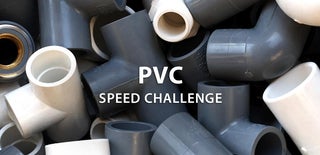Introduction: PVC Mini Greenhouse
This is a cheap, quick, and dirty way to build a mini greenhouse or other structures with PVC pipe, fittings, and a covering. Very few tools are needed and even glue is not required.
Supplies
Materials:
- 3/4" PVC pipe - this is the main structure, we will determine how much in the next step (schedule 40)
- 1" PVC pipe - one 12" to 24" length (also schedule 40)
- 2x 3/4" tee fitting
- 6x 3/4" elbow fitting
- Cover material, like this: https://www.homedepot.com/p/Everbilt-3-ft-x-100-ft-Woven-Housewrap-AK703100/205190086. I chose this because it was cheap and is translucent. A shower curtain or any number of other things can work for this.
Tools:
- Scissors or knife
- Measuring tape
- Tubing cutter or saw
I highly recommend a tool like this for cutting PVC pipe if you're going to be doing a lot of plumbing projects: https://www.homedepot.com/p/Husky-1-1-4-in-Ratcheting-PVC-Cutter-16PL0101-1/304217581. It is better than a saw for most cases because it is fast and doesn't require deburring the ends.
"Schedule 40" is a standard for pipe that indicates the wall thickness, and for these pipes it is the most common in big box stores. The reason this matters for this project is that the internal diameter of the 1" is a close fit for the outside diameter of the 3/4". Other pipe diameters could work and is up to you as long as they fit like this; skip ahead to see where it comes into play.
Step 1: Decide on a Size
The size of your greenhouse is up to you. I sized mine specifically to fit some planters that I had created earlier - luckily this aligned very nicely to the roll of house wrap material linked in the previous step which minimized cutting and made everything very simple.
- Figure the outside dimensions (picture 1)
- Subtract to figure the actual pipe lengths minus the fittings
- Each fitting adds about 3/4 of an inch for this diameter, so your pipes will be about 3 inches shorter than your overall outside measurement.
- Add it all up to determine how much 3/4" PVC pipe is required
The final size of mine is 32" x 22" x 12", which gave me the following:
- 3x 29 inch pipes
- 6x 9 inch pipes
For a total of 141 inches.
In the U.S. PVC pipe is normally sold in 10 foot lengths, so be mindful of how your pieces can all be cut from that.
Step 2: Cut and Assemble
Not much to say about this - put it together! At this size, glue isn't necessary - friction is mostly adequate, and the covering will hold it together once it is added.
Step 3: Make the Clips
This is the clever magic part that makes this great. Cut the 1" pipe into a bunch of small pieces about 1" long, then cut lengthwise to make them into a "C" shape as shown above. These will snap over the 3/4" pipe. Make at least 8 of these.
If you're cutting with a hacksaw, a bench vice to hold them will be very helpful. I've also found that tin snips work well to cut the pipe lengthwise, as does the tubing cutter.
Step 4: Cut and Attach the Covering
The shape for the cover is very simple. Excess material is just folded over itself, so a big rectangle will suffice. I used a piece that was 56" long and 36" wide and it fit nicely.
Wrap the covering over your frame, and use the clips to secure it. Check the photos, this should be pretty self explanatory, much like wrapping a gift.
Step 5: Use It!
I made several of these, and can report that I was able to successfully germinate some plants in my raised barrel planters through a couple of frosts. They also work great to keep birds and critters out.
What else can you do with this idea?
- Make one with a mesh cover to keep out pests. Neighborhood cats think my freshly tilled planters are litter boxes... and it makes me very unhappy when they defecate in the soil where I am trying to grow food.
- Make different shapes - one with legs that is taller for tall plants?
- Fill pipes with sand or water (and glue to seal) to make it heavier to better resist wind?
- Make tall skinny ones that fit over a single pot

Participated in the
PVC Speed Challenge













